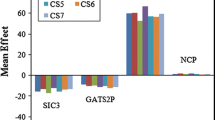Summary
The logarithm of the partition coefficient between n-octanol and water (logP) is an important parameter for drug discovery. Based upon the comparison of several prediction logP models, i.e. Support Vector Machines (SVM), Partial Least Squares (PLS) and Multiple Linear Regression (MLR), the authors reported SVM model is the best one in this paper.
Similar content being viewed by others
Abbreviations
- LogP:
-
the logarithm of the partition coefficient between n-octanol and water
- SVM:
-
support vector machines
- PLS:
-
partial least squares
- MLR:
-
multiple linear regression
References
Mannhold, R. and Dross, K., Calculation procedures for molecular lipophilicity: a comparative study, Quant. Struct.-Act. Relat., 15 (1996) 403–409.
Testa, B., Crivori, P., Reist, M. and Carrupt, P.A., The influence of lipophilicity on the pharmacokinetic behavior of drugs: Concepts and examples, Perspect. Drug Disc. Design, 19 (2000) 179–211.
Hansch, C. and Fujita, T., Correlation of biochemical activity of phenoxyacetic acids with Hammett substituent constants and partition coefficients, Nature, 194 (1962) 178–180.
Leo, A., Calculating logPoct from structures, Chem. Rev., 93 (1993) 1281–1306.
Suzuki, T. and Kudo, Y., Automatic logP estimation based on combined additive modeling methods, J. Comput.-Aided Mol. Des., 4 (1990) 155–198.
Klopman, G., Li, J.Y., Wang, S. and Dimayuga, M., Computer automated logP calculations based on an extended group contribution approach, J. Chem. Inf. Comput. Sci., 34 (1994) 752–781.
Wang, R., Fu, Y. and Lai, L., A new atom-additive method for calculating partition coefficients, J. Chem. Inf. Comput. Sci., 37 (1997) 615–621.
Devillers, J., Domine, D. and Guillon, C., Autocorrelation modeling of lipophilicity with a back-propagation neural network, Eur. J. Med. Chem., 33 (1998) 659–664.
Mannhold, R. and Petrauskas, A., Substructure versus whole molecule approaches for calculating logP, QSAR Comb. Sci., 22 (2003) 466–475.
Sun, H., A universal molecular descriptor system for prediction of logP, logS, logBB, and absorption, J. Chem. Inf. Comput. Sci., 44 (2004) 748–757.
Chuman, H., Mori, A., Tanaka, H., Yamagami, C. and Fujita, T., Analyses of the partition coefficient, logP, using ab initio MO parameter and accessible surface area of solute molecules, J. Pharm. Sci., 93 (2004) 2681–2697.
In, Y., Chai, H.H. and No, K.T., A partition coefficient calculation method with the SFED model, J. Chem. Inf. Model., 45 (2005) 254–263.
Schnackenberg, L.K. and Beger, R.D., Whole-molecule calculation of logP based on molar volume, hydrogen bonds, and simulated 13C NMR spectra, J. Chem. Inf. Model., 45 (2005) 360–365.
Vapnik, V.N. (Ed.) Statistical Learning Theory, John Wiley & Sons, New York, 1998.
Cristianini, N. and Shawe-Taylor, J. (Eds.) An Introduction to Support Vector Machines, Cambridge University Press, Cambridge, UK, 2000.
Burges, C.J.C., A tutorial on Support Vector Machine for pattern recognition, Data Min. Knowl. Disc., 2 (1998) 121–167.
Burbidge, R., Trotter, M., Buxton, B. and Holden, S., Drug design by machine learning: Support Vector Machines for pharmaceutical data analysis, Comput. Chem., 26 (2001) 5–14.
Song, M., Breneman, C.M., Bi, J.; Sukumar, N., Bennett, K.P., Cramer, S. and Tugcu, N., Prediction of protein retention times in anion-exchange chromatography systems using Support Vector Regression, J. Chem. Inf. Comput. Sci., 42 (2002) 1347–1357.
Kramer, S., Frank, E. and Helma, C., Fragment generation and Support Vector Machines for inducing SARs, SAR QSAR Environ. Res., 13 (2002) 509–523.
Zernov, V.V., Balakin, K.V., Ivaschenko, A.A., Savchuk, N.P. and Pletnev, I.V., Drug discovery using Support Vector Machines. The case studies of drug-likeness, agrochemical-likeness, and enzyme inhibition predictions, J. Chem. Inf. Comput. Sci., 43 (2003) 2048–2056.
Yao, X.J., Panaye, A., Doucet, J.P., Zhang, R.S., Chen, H.F., Liu, M.C., Hu, Z.D. and Fan, B.T., Comparative study of QSAR/QSPR correlations using Support Vector Machines, Radial Basis Function Neural Networks, and Multiple Linear Regression, J. Chem. Inf. Comput. Sci., 44 (2004) 1257–1266.
Luan, F., Zhang, R.S., Zhao, C.Y., Yao, X.J., Liu, M.C., Hu, Z.D. and Fan, B.T., Classification of the carcinogenicity of N-nitroso compounds based on Support Vector Machines and Linear Discriminant Analysis, Chem. Res. Toxicol., 18 (2005) 198–203.
Hansch, C., Leo, A. and Hoekman, D. (Eds.) Exploring QSAR: Hydrophobic, Electronic, and Steric Constants, Vol 2, American Chemical Society, Washington, DC, 1995.
Zefirov, N.S. and Palyulin, V.A., Fragmental approach in QSPR, J. Chem. Inf. Comput. Sci., 42 (2002) 1112–1122.
Hurst T. and Heritage T., HQSAR — A highly predictive QSAR technique based on molecular holograms, 213th ACS Natl. Meeting, San Francisco, CA, (1997), CINF 019.
Merlot, C., Domine, D., Cleva, C. and Church, D.J., Chemical substructures in drug discovery. Drug, Discovery Today, 8 (2003) 594–602.
Clark, M., Generalized fragment-substructure based property prediction method, J. Chem. Inf. Model, 45 (2005) 30–38.
Liao, Q., Yao, J.H., Li, F., Yuan, S.G., Doucet, J.P., Panaye, A. and Fan, B.T., CISOC-PSCT: A predictive system for carcinogenic toxicity, SAR QSAR Environ. Res., 15 (2004) 217–235.
Eriksson, L., Johansson, E., Kettaneh-Wold, N. and Wold, S. (Ed.) Multi- and Megavariate Data Analysis Principles and Applications, Umetrics Academy: Kinnelon, NJ, 2001.
Topliss, J.G. and Edwards, R.P., Chance factors in studies of quantitative structure-activity relationships, J. Med. Chem., 22 (1979) 1238–1244.
Press, W.H., Teukolsky, S.A., Vetterling, W.T. and Flannery, B.P. (Eds.) Numerical Recipes in C: the Art of Scientific Computing, 2nd Ed., Cambridge University Press, Cambridge, 1995, 676–681.
Chang, C.C. and Lin, C.J., LIBSVM – A library for Support Vector Machines, http://www.csie.ntu.edu.tw/$\sim$cjlin/libsvm/index.html.
Author information
Authors and Affiliations
Corresponding author
Rights and permissions
About this article
Cite this article
Liao, Q., Yao, J. & Yuan, S. SVM approach for predicting LogP. Mol Divers 10, 301–309 (2006). https://doi.org/10.1007/s11030-006-9036-2
Received:
Accepted:
Published:
Issue Date:
DOI: https://doi.org/10.1007/s11030-006-9036-2




